
The 5th Battalions have had a long and distinguished career in the Australian Army dating back to its formation in 1885 in the city of Bendigo, as part of Victoria's colonial military forces. After Federation in 1901 the military forces were reorganised and the 5th Infantry Regiment was established in Melbourne. Following the outbreak of war in August 1914, the 5th Battalion was raised in Melbourne as part of the First Australian Imperial Force.
Staff Officers of the Victorian Volunteer Force.
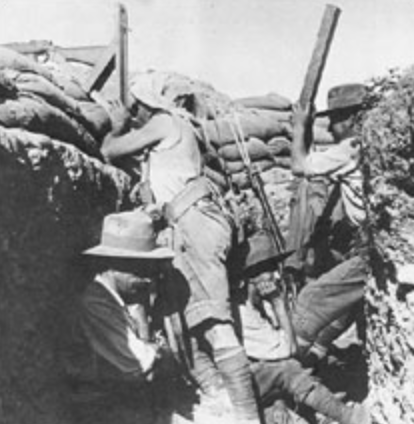
Diggers in an Australian trench at ANZAC. One man is using a periscope rifle, invented by an Australian at Gallipoli, while another spots for him.)
The 5th Battalion was among the first infantry units raised for the AIF during the First World War. Like the 6th, 7th and 8th Battalions it was recruited from Victoria and, together with these battalions, formed the 2nd Brigade.
The battalion was raised within a fortnight of the declaration of war in August 1914 and embarked just two months later. After a brief stop in Albany, Western Australia, the battalion proceeded to Egypt, arriving on 2 December. It later took part in the ANZAC landing on 25 April 1915, as part of the second wave. It was led by Lieutenant Colonel D. S. Wanliss, the officer who had raised the battalion. Ten days after the landing the 2nd Brigade was transferred from ANZAC to Cape Helles to help in the attack on the village of Krithia. The attack captured little ground but cost the brigade almost a third of its strength. The Victorian battalions' forming the 2nd Brigade returned to ANZAC to help defend the beachhead, and in August the 2nd Brigade fought at the battle of Lone Pine. The battalion served at ANZAC until the evacuation in December.
After the withdrawal from Gallipoli, the battalion returned to Egypt and, in March 1916, sailed for France and the Western Front. From then until 1918 the battalion was heavily involved in operations against the German Army. The battalion's first major action in France was at Pozières in the Somme valley in July 1916. After Pozières the battalion fought at Ypres in Flanders then returning to the Somme for winter.
In 1917, the battalion participated in the operations that followed-up the German withdrawal to the Hindenburg Line, and then returned to Belgium to join the great offensive launched to the east of Ypres. In March and April 1918, the battalion helped to stop the German spring offensive. It subsequently participated in the great Allied offensive launched near Amiens on 8 August 1918. The advance by British and empire troops was the greatest success in a single day on the Western Front, one that German General Erich Ludendorff described as "the black day of the German Army in this war".

The ruins of Ypres stands in the background as Australians move towards a frontline position on 25 October 1917.)
The battalion continued operations until late September 1918. At 11 am on 11 November 1918, the guns fell silent. The November armistice was followed by the peace treaty of Versailles signed on 28 June 1919.
In November 1918 members of the 5th Battalion AIF began to return to Australia for demobilisation and discharge.

5th Battalion AIF Colour Patch
Battle Honours
Casualties
Awards
2/5th Battalion AIF

2/5th soldiers moving on Bardia 3 January 1941.)
The 2/5th Battalion formed in Melbourne on 18 October 1939, as part of the 17th Brigade of the 6th Australian Division. The nucleus of the battalion was assembled in ensuing days at the Royal Melbourne Showgrounds, but its first drafts of recruits were not received until after it moved to the newly-established camp at Puckapunyal on 2 November. Basic training was completed there prior to the battalion's departure for overseas service on 14 April 1940.
After arriving in the Middle East on 18 May 1940, the battalion undertook further training in Palestine and Egypt. The 2/5th took part in its first campaign - the advance against the Italians in eastern Libya in January and February 1941, and participated in successful attacks at Bardia (3-5 January) and Tobruk (21-22 January). In early April, the 2/5th, with the rest of the 6th Division, deployed to Greece to resist the anticipated German invasion. For the 2/5th, the Greek campaign was essentially one long withdrawal from its initial defensive positions at Kalabaka (occupied on 14 April) to the port of Kalamata, from which it was evacuated on 27 April. A party of approximately 50 transport drivers were left behind in Greece and became prisoners. A similar sized group landed on Crete and, after fighting with the 17th Brigade Composite Battalion, also suffered the same fate
Back in Palestine, the 2/5th was given little respite. In June and July 1941, it took part in the campaign in Syria, including the climactic battle of Damour (6-10 July) that sealed the defeat of the Vichy French forces. The battalion was destined to remain in Syria and Lebanon as part of the garrison force there until January 1942. It left the Middle East, heading for the war against Japan, on 10 March 1942. The 16th and 17th Brigades, however, were diverted on the voyage home. From early March to early July they defended Ceylon (present-day Sri Lanka) from possible Japanese attack. The 2/5th finally disembarked in Australia, at Melbourne, on 4 August 1942.
The 2/5th deployed to Milne Bay, in Papua, in early October 1942 but did not meet the Japanese in battle until the end of January 1943, when it joined the force defending Wau, in New Guinea. After much desperate fighting, the Japanese around Wau were defeated in early February. The 2/5th subsequently participated in the drive towards Salamaua and was heavily engaged around Goodview and Mount Tambu in July and August. After arriving back in Australia at Cairns on 23 September 1943, the 2/5th spent most of 1944 training in northern Queensland.
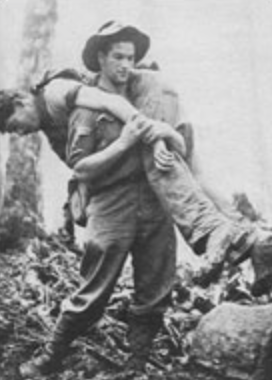
Cpl L. 'Bull' Allen carrying a wounded American Soldier out of the battle on Mount Tambu.
On 29 November 1944, the 2/5th disembarked at Aitape in New Guinea for its last campaign of the war. It spent much of the next seven months engaged mainly in arduous patrolling to clear the Japanese from the Torricelli and Prince Alexander mountain ranges. It was still engaged in this role when the war ended on 15 August 1945. The battalion embarked to return to Australia on 1 December and disbanded at Puckapunyal in early February 1946. It was one of only two battalions that fought all of Australia's major enemies during the Second World War.
The 2/5th Battalion was disbanded in 1946 but the Victorian Scottish Regiment has continued the unbroken service of the 5th Battalions' since that time.

2/5th Battalion AIF Colour Patch
Battle Honours
Casualties
Awards
5th Battalion The Royal Australian Regiment

A patrol from the 5th Battalion returning to Nui Dat.
On the 1st of March 1965, the 5th Battalion, the Royal Australian Regiment was raised at Holsworthy Barracks Liverpool, NSW. the Army needed to expand from four to nine battalions. In 1965, the 1st Battalion, organised on the Pentropic establishment (in theory some 1,300 men) was split to provide a cadre of regulars to the new 5th Battalion, whilst conscripts were used to bring the unit up to strength.
Upon arrival in South Vietnam the battalion, under command of Lieutenant Colonel John Warr, commenced operations on 24 May 1966 by participating in the clearance of the 1st Australian Task Force base at Nui Dat #8211; Operation Hardihood. For this operation the battalion was under the command of 173rd (US) Airborne Brigade and worked alongside two American parachute battalions to clear the area out to mortar range, so that the base could be established. It was on this operation that the battalion's first soldier, Private Errol Noack, a 21-year old from Adelaide, South Australia, was the first National Serviceman to be killed in Vietnam.
Attempting to restore the control of the South Vietnamese Government to the areas of population which had been cut off by the Viet Cong (or VC), who controlled many of the villages and the supply routes between the towns, was a key focus for the battalion. It therefore attempted to drive out the village cadres and Viet Cong through cordon and search operations, numerous successful ambushes, and by establishing a good local intelligence network #8211; largely through close relations with the senior members of each village. Many of the villagers did not support the Viet Cong regime due to the heavy taxes they levied, the manner in which they restricted civilian travel to the various markets for trade, and because they conscripted those of military age. As the battalion did not have the manpower to patrol the areas in the north of the province in search of regular Viet Cong units, they chose to concentrate on the villages in an attempt to destroy the Viet Cong power base. These operations were largely successful and the techniques developed in their execution were to be accepted and used throughout the Australian Army. Prior to the arrival of 5 RAR only 24,775 of the inhabitants of Phuoc Tuy Province were under South Vietnamese Government control in 24 hamlets. However, by April 1967, 98,408 villagers were under Government control in 105 hamlets. 5RAR killed 70 Viet Cong... Many hundreds more Viet Cong were captured either in conventional operations or during cordon and search operations. However, the important statistics of the Battalion's tour remain the number of Vietnamese people who supported the Vietnamese Government and the degree of Government control established by 5RAR during their first tour of Vietnam. 5RAR had laid a sturdy platform for future battalions due to their innovative use of tactics, hard training, the professionalism with which they carried out their tasks and the subsequent respect won from the Vietnamese people.
In total the 5th Battalion conducted eighteen separate operations. The battalion returned to Australia in April 1967 and marched through the streets of Sydney on 16 May 1967; 25 men were killed in action or died of wounds, while 79 were wounded in action.
The 5th Battalion commenced its second tour of South Vietnam in February 1969, this time under the command of Lieutenant Colonel C. N. Khan.
During the second tour the emphasis [of operations] turned more towards route denial and conventional operations involving seeking out and closing with the guerilla and Main Force units such as D445 Battalion and 274 Regiment. Ambush and reconnaissance tasks were also conducted at platoon and company level. Attacks and the clearance of bunker systems played a major part of operations.
Towards the end of the tour, elements of the Battalion also contributed to the pacification process through the construction of schools and housing and through the provision of medical and dental support to such villages as Ong Trinh and Phuoc Le. Operations were also characterised by a higher number of mine incidents than had been experienced previously. 'The majority of the mines were taken by the VC from a barrier minefield laid by the Australians between the Horseshoe [feature] and Phuoc Hai. The enemy used these mines offensively rather than using them to protect their bases. The VC would lay the mines on tracks, in likely ambush and harbour locations, and around houses and villages. During Operations Esso I, II and III in June and July 1969, special precautions were taken to counter the problem of mines. Special training was conducted, all vehicle floors were sandbagged, flak jackets and helmets worn whenever possible, and mine detectors used by all patrols. Despite these precautions, seven soldiers were killed and 43 were wounded by mines on these operations alone'.
Arguably the most well known action ever fought by the 5th Battalion was the Battle of Binh Ba, which took place between 6 and 8 June 1969 and saw the defeat of a well armed and determined North Vietnamese Army (NVA) battalion.
By the time it returned home in February 1970, the Battalion had carried out some 18 operations during its twelve-month operational tour and suffered 25 men killed in action or died of wounds, and 202 wounded in action.
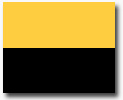
Original Colour Patch
Casualties
Awards
5/7th Battalion The Royal Australian Regiment
Following Australia's withdrawal of military forces from Vietnam in 1972 the government decided to link 6 battalions of regular infantry. Rather than see units disbanded permanently it was decided that they would be linked as a temporary measure so as to preserve their history, customs and traditions. So on 3 December 1973 the 5th and 7th Battalions, then serving together at Holsworthy, were linked in a formal parade. Thus was born the 5th/7th Battalion. The other linked battalions formed were 2/4 RAR and 8/9 RAR.
5/7RAR initially served in the light role before undertaking a mechanised trial in the early 1980s, which led to the adoption of the mechanised role in 1984. During its 33-year existence 5/7RAR conducted three operational tours as a unit. The first was to East Timor from October 1999 to April 2000. This deployment saw the unit serve with the International Force in East Timor (INTERFET) and then as the first Australian Battalion (or AUSBA TT I) under the United Nations Transitional Authority in East Timor (UNTAET). The unit later served a second UN tour of East Timor as AUSBATT VII from October 2002 to May 2003. The third operational tour was as the Al Muthanna Task Group 2 (AMTG 2) in Iraq from November 2005 to May 2006.5/7 RAR also had sub-unit level deployments to Iraq (such as D Company as Security Detachment 5 in Baghdad in 2004 and B Company with AMTG 1 in 2005) and Solomon Islands, as well as a number of other deployments involving small groups or individuals to such places as Rwanda, Cambodia, and Bougainville
Return to the Order of Battle
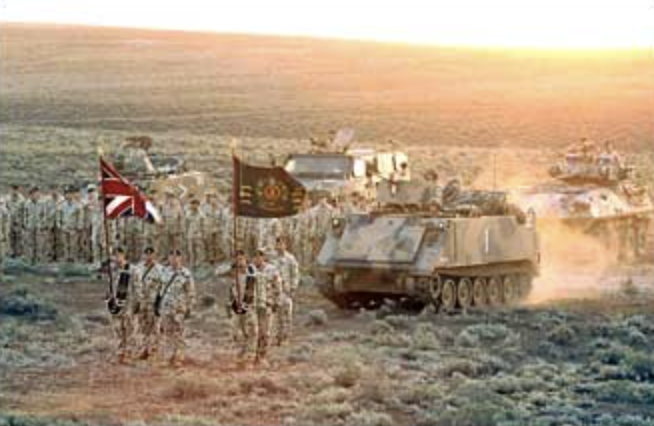
On the 3rd of December 2006 saw 5RAR de-linked from 7RAR and became once again a battalion within its own right within the Royal Australian Regiment. The De-Linking Ceremony was conducted at 1 Brigade Parade Ground, Robertson Barracks Darwin.
Left: re-dedication of the colours in the field)
At the time of the de-linking D Company, 5/7RAR was serving as a part of Overwatch Battle Group (West) 2 in southern Iraq and B Company 5/7RAR was serving with the 1st Reconstruction Task Force in Afghanistan. Battalion headquarters, Support Company, C and D Companies, and most of Logistics Company became 5RAR, whilst B Company joined 7 RAR's newly raised headquarters and A Company. The two battalions remained at Binh Ba Lines in a mixture of 5/7 RAR's old buildings and temporary accommodation until 7RAR's new facilities, Horseshoe Lines, were completed in Adelaide.
On the 14 February 2007, on a hilltop overlooking Port Augusta, the Tiger Battalion re-dedicated itself to its Colours in a ceremony at Cultana Field Training Area. CO 5RAR, Lt-Col Jake Ellwood, said the Colours, which were originally consecrated and blessed on October 29, 1967, symbolise the regiment's important links with its history, traditions and its soldiers.
"The rededication of the Colours was perfectly timed as members of the Tiger Battalion prepare for a deployment on Op Catalyst," he said.
OBG(W)-3 comprises 5RAR, and elements of 2 Cav Regt, 1CSSB, 1CSR and the Australian Army Training Team-8, are training hard in the countdown to their deployment to Operation Catalyst."
Lt-Col Ellwood said the re-dedication of the Colours follows the de-linking of 5/7 RAR and the re-raising of 5RAR on December 3, 2006, after 33 years to the day as 5/7RAR. The original Colours were laid up at Kapooka (with 7RAR Colours) in April 2004. The ceremony marked a small milestone in Australian military history, with the Tiger Battalion being the first unit to re-dedicate itself to its original Colours.
5RAR Iraq

The Australian Government announced that it would deploy a battle group to southern Iraq. Initially known as the Al Muthanna Task Group (AMTG) this combined arms organisation was officially tasked with providing security to the Japanese Iraq Reconstruction Support Group (JIRSG) undertaking humanitarian assistance and conducting construction work in Al Muthanna.
Left: PTE Couldridge making an impression with some of the youngrt Iraqi locals
The return of 5RAR to the Australian Army's order of battle in December 2006 meant that OBG(W) 2's infantry combat team was retitled D Company, 5RAR, making it the first element of the Battalion to serve on operations since Vietnam.
In March 2007 5RAR was warned for service as the fifth rotation of forces in southern Iraq (OBG(W) 3). The Battalion provided the headquarters, C Company (Combat Team Sabre) and logistic elements to the Battle Group. 5 RAR conducted counter-insurgency operations in the Al Muthanna and Dhi Qar Governorates from June until December 2007.
5RAR East Timor
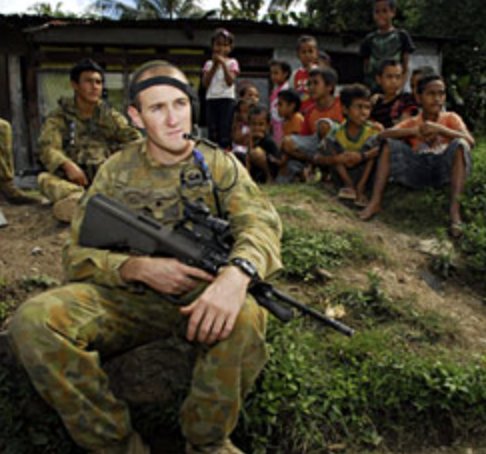
In October 2008 5RAR deployed again, this time as Timor Leste Battle Group 5 on Operation Astute, as part of the International Stabilisation Force in East Timor. After handing over to 2RAR, the Battalion returned to Australia in June 2009.
Left: A 5RAR Patrol takes a break with the Timorese children looking on.
5RAR Afghanistan
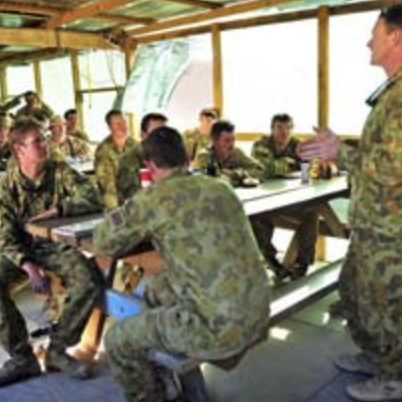
In October 2008 one of 5RAR's mortar sections deployed to Afghanistan to reinforce the 7th Battalion, Royal Australian Regiment as they mounted Mentoring and Reconstruction Task Force Two (MRTF-2). This section became the first mortar section from the battalion to fire high explosive rounds in anger supporting troops in contact since the Vietnam War.
In September 2010, 5RAR was deployed to Afghanistan as the mounting unit of Mentoring Task Force Two (MTF-2). The battle group deployed to Uruzugan Province as one of the two infantry battalions that made up the main fighting force of Combined Team Uruzgan (CTU).
Left: Commanding officer Mentoring Task Force Two, (MTF-2) LTCOL Darren Huxley addresses his soldiers at a patrol base in the Chorah Valley region of Southern Afghanistan
The battalion's mission in Afghanistan was the mentoring Afghan National Army personnel of the 4th Brigade, 205th Hero Corps, based in Uruzgan Province. Due to the MTF-2's mission, the rifle companies did not deploy docrintally. Rather each of the companies were transformed into Mentoring Combat Teams. Each Combat Team had four Operational Mentoring and Liaison Teams (OMLTs) which generally consisted of infantry mentors, a small infantry force protection element, an engineer search team, a Joint Fires Team, and a medic. Each of the OMLTs were led by either a Lieutenant or a Captain, and generally also had a Sergeant or Warrant Officer Class Two as the Team Sergeant Major. Each of the OMLTs were responsible for mentoring an Afghan National Army infantry company, and generally most of these companies were located at individual and isolated Patrol Bases or Combat Outposts with Uruzgan Province. OMLTs were required to live embedded with Afghan National Army units, and mentor them.
MTF-2 conducted large amounts of normal framework operations as well as deliberate clearance and strike operations throughout the deployment whilst mentoring the Afghan National Army through the conduct of these operations. By and large, the battalion had significant success against the enemy throughout the tour, with huge amounts of weapons, ammunition, explosives etc. being recovered or captured, large amounts of enemy combatants being killed or captured, and significant amounts of ground being captured and held. In particular MTF-2 was widely praised was the large amounts of ground that was captured and held throughout the tour, which allowed CTU to expand further into Taliban strongholds.
MTF-2 suffered three fatalities during the tour. In addition another nine members of MTF-2 were wounded during the deployment, a number of them seriously. 5RAR completed its mission as the mounting unit of MTF-2 in June 2011.

Colour Patch

Overwatch Battlegroup (W) 3 Iraq
Awards
(To be updated)

Mentoring Task Force 2 Afghanistan
Casualties
Awards
"In peace, there is nothing so becomes a man as modest stillness and humility; But when the blast of war blows in our ears, Then imitate the action of the Tiger. Stiffen the sinews, summon up the blood, disguise fair nature with hard-favour'd rage; Then lend the eye a terrible aspect."
"William Shakspeare, HENRY V, 111,i";
The above was quoted by the first commanding officer of 5RAR, Lt-Col P.H.G. Oxley OBE in March 1965, in the battalion's auditorium when addressing members of the newly formed battalion and on advising them of the selection of the Sumatran Tiger as the battalion's mascot.
Alliance
United Kingdom - Welsh Guards
Bibliography
Wikipedia The Free Encyclopedia (2014) 5th Battalion The Royal Australian Regiment. online.
http://en.wikipedia.org/wiki/5th_Battalion,_Royal_Australian_Regiment
O'Neill R. J. (1968), Vietnam Task, Melbourne Australia, Cassel Australia Ltd.
Battle M.A. (1970), The Year of the Tigers, Melbourne Australia, 5 RAR Association.
5th Battalion The Royal Australian Regiment.
